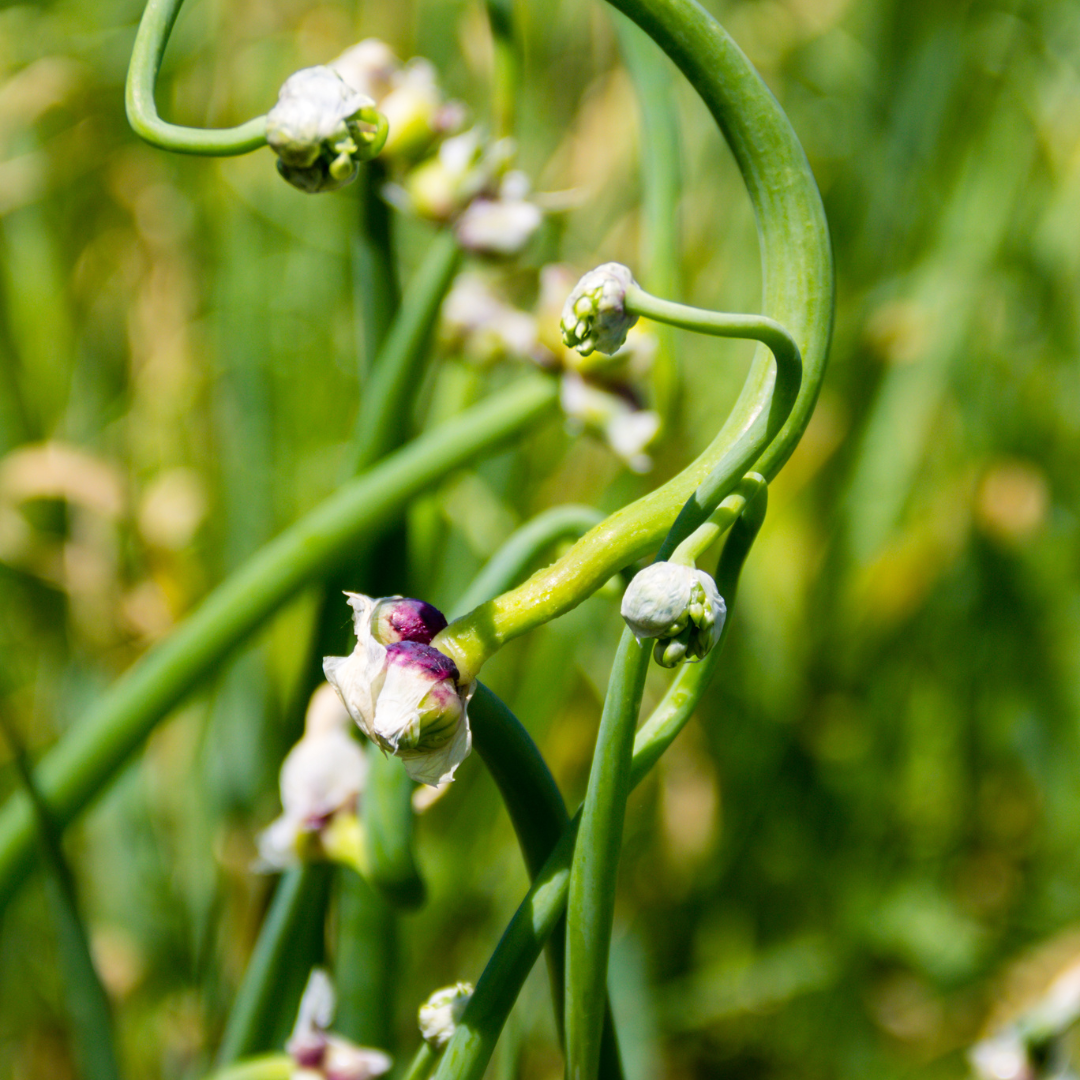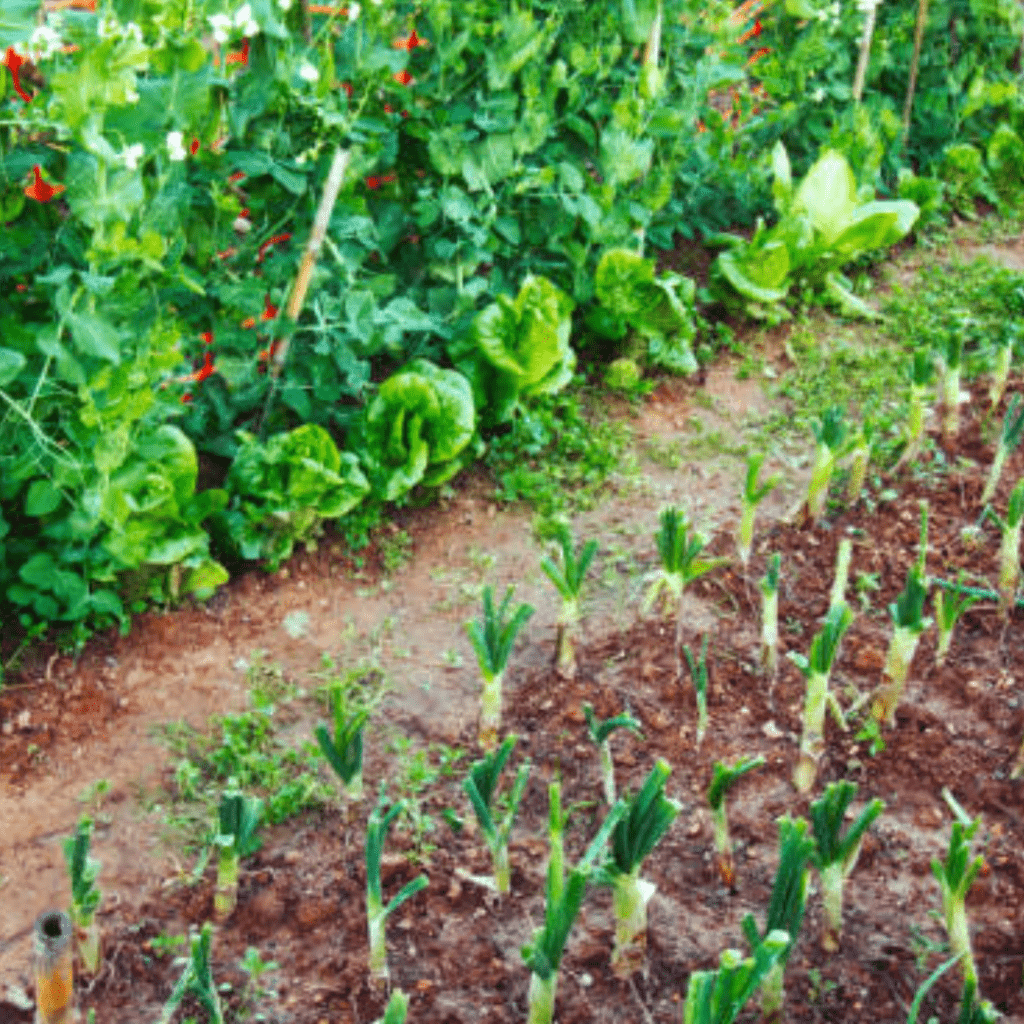Egyptian walking onions are a must-have for any survival garden. These perennial onions are hardy, self-propagating, and thrive with minimal care, making them an ideal crop for self-sufficiency and food security. In this guide, I’ll share why I grow a patch of these fascinating onions in my own survival garden, how you can grow them too, and where to buy reliable starter sets—plus affiliate links to help you get started!
What Are Egyptian Walking Onions?
Egyptian walking onions (Allium × proliferum) are a perennial, cold-hardy onion variety that grows small bulbs (called bulbils) at the top of their stalks instead of seeds. When these bulbils get heavy, the stalk bends down to the soil, where the bulbils root themselves and “walk” to a new location—hence the name Egyptian walking onions.
These onions are incredibly low-maintenance, resilient to pests, and grow well in zones 3–10. Best of all, once established, they keep producing for years with almost no effort—perfect for any self-reliant gardener.
This is a pinnable post. Tap or hover over any image in this post to pin to your Pinterest Boards.
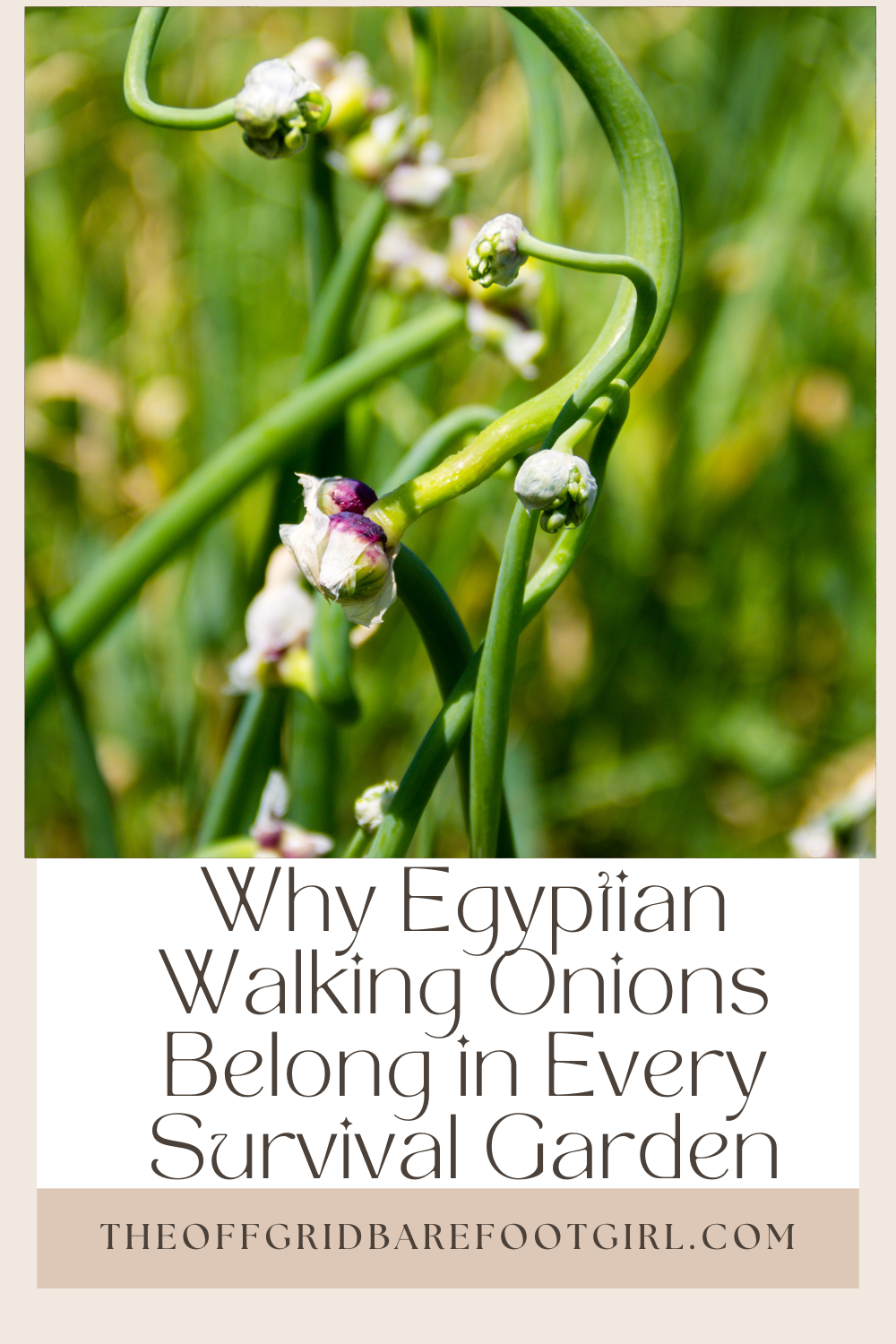
Why Egyptian Walking Onions Are Perfect for a Survival Garden
1. They’re Perennial and Self-Replanting
Unlike traditional onions, Egyptian walking onions don’t need to be replanted every year, which makes them a dream crop for self-sufficient gardeners. Once you plant a patch, these resilient perennials take care of themselves! As the season progresses, they grow tall green stalks topped with clusters of small bulbs, called bulbils. When the bulbils become heavy, the stalk naturally bends toward the ground, where the bulbils take root and start a new plant!
Over time, this self-planting process causes the onions to “walk” across your garden bed—hence the name! This natural propagation means you can plant them once and enjoy year-after-year harvests with minimal upkeep, making them ideal for survival gardens, off-grid homesteads, and low-maintenance food systems.
2. They Survive Harsh Conditions
These onions are incredibly hardy and almost impossible to kill, which is exactly what you want in a survival garden. I’ve had my Egyptian walking onions survive heavy snow, intense summer drought, gusty mountain winds (I live in Northern Utah), and even periods of complete neglect—yet they come back stronger every year. With just a layer of mulch for protection, they keep pushing up fresh green shoots in early spring and stay productive well into fall.
Their toughness makes them a reliable food source in unpredictable climates or crisis situations. When other crops fail or need babying, walking onions keep on growing. In a true survival scenario where resilience matters more than high yield or aesthetics, this kind of low-maintenance, high-reward plant is absolutely gold. It’s one of the few crops I trust to thrive no matter what nature throws at it.
3. Multiple Edible Parts
One of the things I love most about Egyptian walking onions is how incredibly versatile they are in the kitchen—you truly get three distinct harvests from a single plant. The green tops can be snipped and used just like scallions or spring onions. They’re perfect for tossing into scrambled eggs, adding a fresh bite to soups, or sprinkling on top of baked potatoes. The underground bulbs, which grow more like shallots, are mildly sweet and flavorful—great for roasting, caramelizing, or using as the base of savory dishes.
And don’t overlook the quirky little bulbils that grow at the top of the stalks! These can be replanted, of course, but they’re also edible and delicious when pickled or sautéed. I like to pickle them with garlic and dill for a tangy treat that lasts all winter. With so many edible parts, Egyptian walking onions are a true triple-threat in the survival garden—one plant, three harvests, and endless meal possibilities.
4. No Seeds Required
Forget the hassle of storing seeds, starting trays indoors, or keeping track of planting schedules—Egyptian walking onions handle their own reproduction through bulbils, making them one of the most hands-off crops you can grow. These little top-set bulbs develop naturally at the end of the onion’s green stalks. When mature, they drop to the ground and root themselves, starting a new generation without any help from you. This means you don’t have to buy new seed every season or worry about rotating crops to make space for onions—your patch will expand all on its own.
In a long-term survival or off-grid scenario where access to seeds may be limited or unreliable, this kind of self-sustaining plant is an enormous advantage. It’s one less thing to manage, store, or potentially lose in a crisis. Once established, walking onions create a continuous, low-maintenance food source that fits seamlessly into a closed-loop, regenerative garden system—which is exactly what self-sufficiency is all about.
Why I Grow Egyptian Walking Onions in My Own Survival Garden
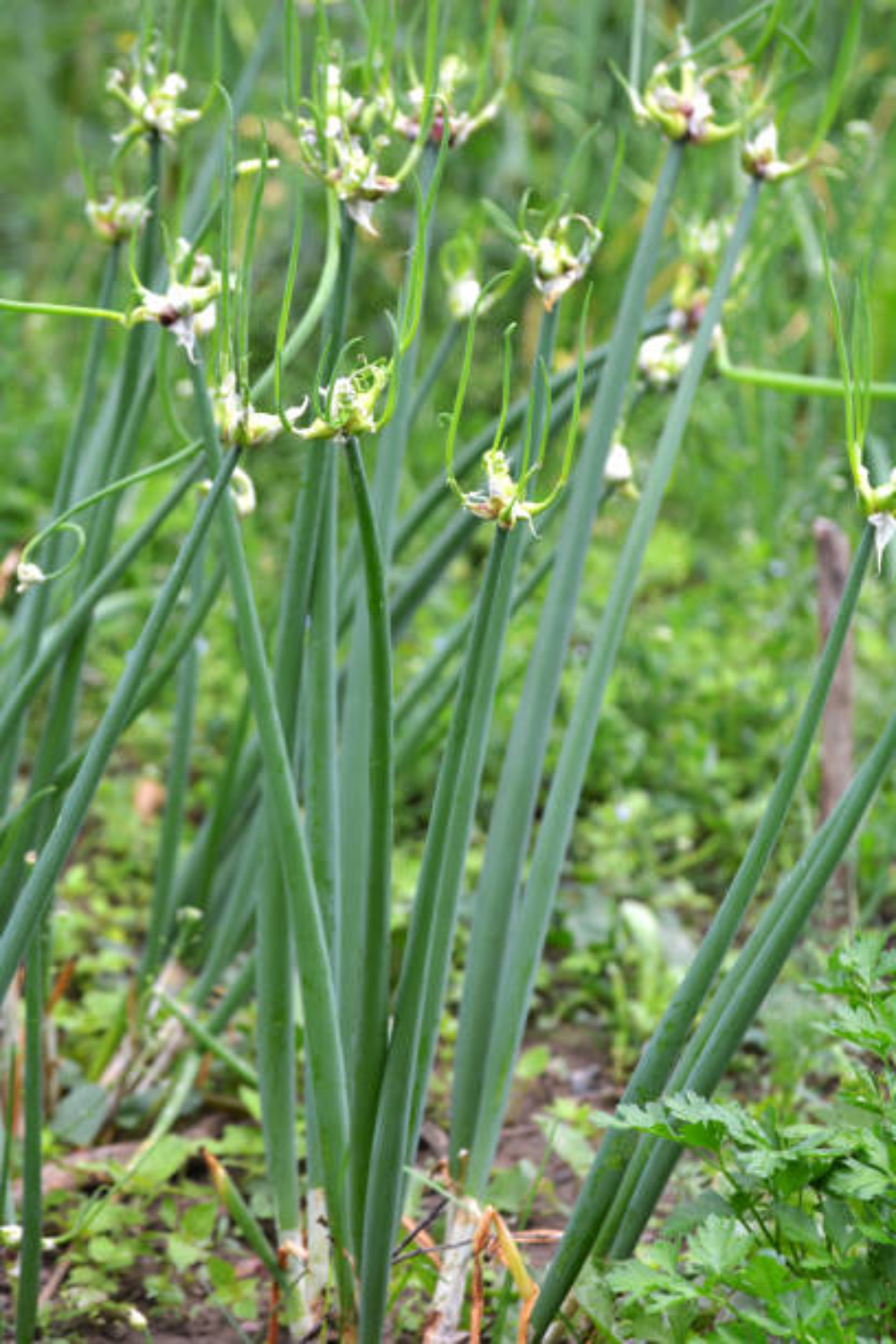
I started growing Egyptian walking onions a few years ago as part of building a more resilient, off-grid food system for my family. On my remote childhood homestead orchard, we had these growing on the edges of our property in the weeds and berry patches alonside a hillside stream. I remember picking the green tops and eating them fresh while playing in the yard with my sisters. They grew wild and I learned to love the taste of onions! Here’s why they earned a permanent spot in my garden:
- I never have to replant them—huge time-saver!
- They give me green onions even in late fall and early spring.
- They’re one of the few plants I trust to survive neglect or bad weather.
- They’re a conversation starter—everyone who visits asks about them!
Whether you’re new to self-sufficiency or building a survival garden, these onions are one of the easiest crops to manage—and most rewarding!
How to Grow Egyptian Walking Onions
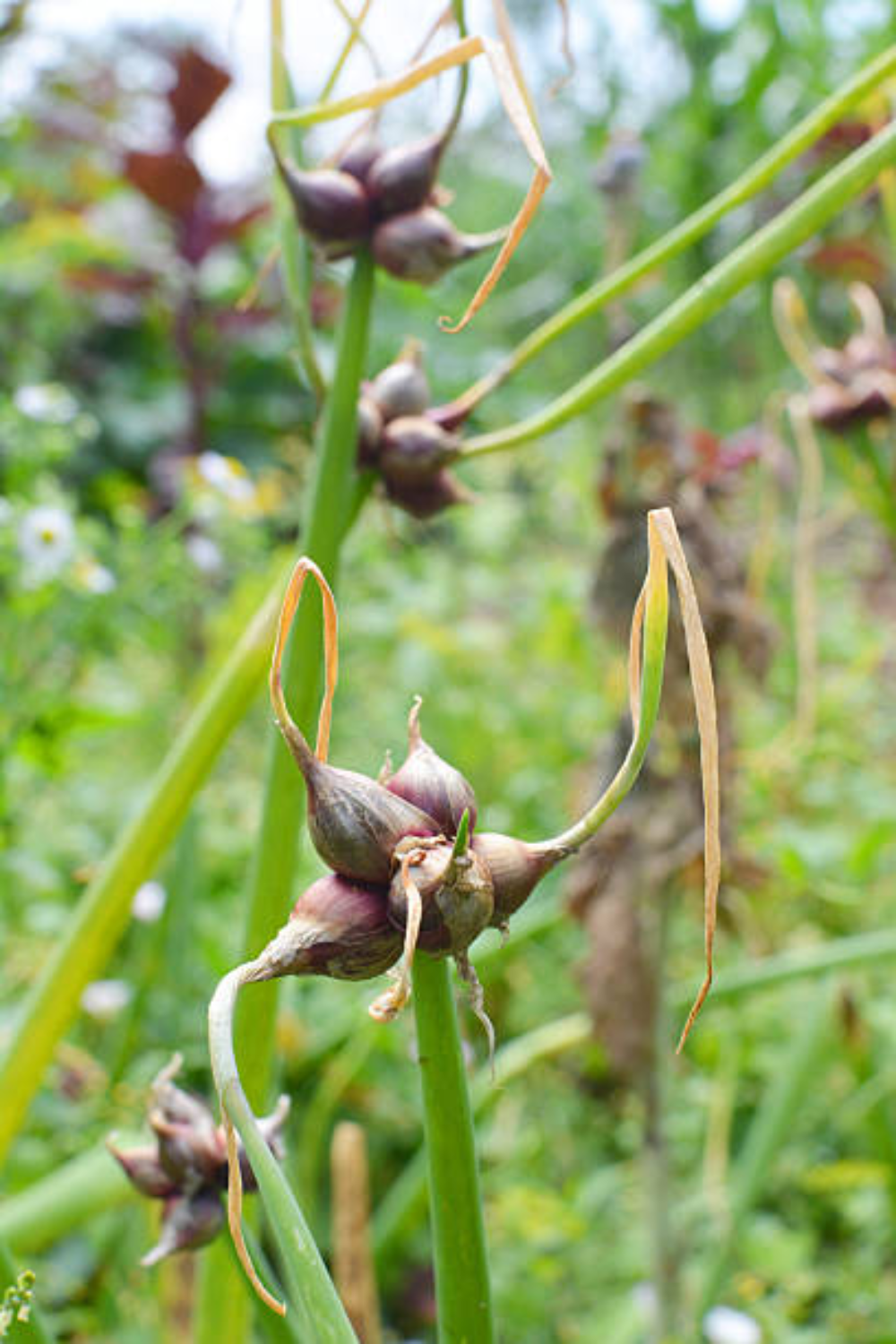
Where and When to Plant
Planting Egyptian Walking Onions Is Simple and Flexible
Whether you’re working with a full-size homestead or a compact backyard survival garden, Egyptian walking onions are incredibly easy to plant and establish. You can start them from either the bulbils (the small bulbs that grow at the top of the plant) or by dividing existing underground bulbs. The best times to plant are in the fall or early spring, giving the onions time to root before extreme temperatures hit.
These onions love full sun and well-drained soil, but they’re not picky—making them perfect for unpredictable survival situations. They do well in a variety of growing environments, including raised beds, containers, or directly in garden soil. I’ve even seen them thrive in neglected corners of a yard where other crops struggled. Their flexibility makes them an ideal choice for preppers or gardeners looking to maximize food production with minimal effort.
Once planted, they require very little attention. Just keep the soil from becoming waterlogged and give them a layer of mulch before heavy frosts. That’s it! This low-maintenance nature means more time to focus on other critical survival garden tasks!
Soil and Spacing Tips
Prepare Nutrient-Rich Soil and Space Egyptian Walking Onions Properly for Best Growth
For the best results, plant your Egyptian walking onions in rich, compost-amended soil. These onions thrive when given plenty of organic matter, which improves soil fertility, moisture retention, and drainage—all essential for healthy bulb development and vigorous growth. Before planting, work generous amounts of well-rotted compost or aged manure into your garden bed or container soil to create a nutrient-dense environment.
When it comes to spacing, give each bulb or bulbil about 6 inches of room. This distance allows the plants to spread naturally as they “walk” and multiply over time without becoming overcrowded. Overcrowding can lead to smaller bulbs and reduced airflow, which might increase the risk of disease. Leaving adequate space helps maintain healthy plants and makes harvesting easier. Plus, as the onions send out new shoots and bulbils, they’ll gradually fill in the gaps, creating a thriving perennial patch that keeps expanding season after season.
If you’re planting in rows, space the rows about 12 inches apart to allow for easy access and maintenance. This setup works well in raised beds or garden plots and encourages optimal airflow, sunlight exposure, and overall plant health.
Watering and Care
Watering Egyptian Walking Onions: Finding the Right Balance
When it comes to watering Egyptian walking onions, moderation is key. These hardy onions are naturally drought-tolerant, making them well-suited for survival gardens and low-maintenance growing conditions. While they do appreciate moisture—especially during dry spells or extended hot periods—they don’t like to sit in waterlogged or soggy soil. Overwatering can lead to root rot or fungal issues, which will weaken the plants and reduce your harvest.
To keep your onions happy, water deeply but infrequently, allowing the soil to dry out slightly between waterings. A good rule of thumb is to check the top inch of soil; if it feels dry, it’s time to water. Mulching around the plants can also help retain soil moisture during dry times, reduce evaporation, and keep the roots cool.
By balancing watering carefully, you’ll help your Egyptian walking onions stay healthy, productive, and resilient—even in less-than-ideal weather conditions. This balance is another reason why these onions are such a reliable choice for long-term, self-sufficient gardening.
Harvesting
When and How to Harvest Egyptian Walking Onions for Maximum Flavor and Yield
Knowing when and how to harvest each part of the Egyptian walking onion is key to making the most of this versatile plant. Whether you’re after fresh green tops, flavorful underground bulbs, or the unique bulbils that give these onions their name, timing your harvests correctly will ensure you enjoy peak flavor and maximize your yield throughout the growing season.
- Green tops: anytime during the growing season
- Underground bulbs: late summer or fall
- Bulbils: when tops bend over—replant or harvest for pickling!
Where to Buy Egyptian Walking Onions
If you’re ready to grow your own, here are some reliable affiliate links to Egyptian Walking Onion sets on Amazon:
➡️ Egyptian Walking Onion Bulbs – 10 Bulbils Starter Pack (Amazon)
➡️ Perennial Onion Collection – Great for Homesteads (Amazon)
➡️ Gardener’s Raised Bed Planter (Perfect for Perennials)
➡️ Organic Compost for Vegetable Gardens
How to Use Egyptian Walking Onions in the Kitchen
- Use the greens like scallions in soups, salads, and omelets.
- Harvest the underground bulbs like shallots for roasting or stir-fries.
- Pickle the top bulbils with vinegar, salt, and herbs for a delicious topping.
They add flavor to just about everything, and they store well, too!
Conclusion
Egyptian walking onions aren’t just interesting—they’re practical, productive, and perfect for survival gardening. Whether you’re preparing for food shortages, going off-grid, or just want a low-maintenance food source, these perennial onions are worth their weight in gold! I grow them, I eat them, and I highly recommend them to anyone serious about self-sufficiency!
Grab a set, plant once, and enjoy onions year after year.
Resources: Here are some helpful resources for further information.
- Egyptian Walking Onion – By Egyptian Walking Onion
- Egyptian Walking Onion (Tree Onion) – By Southern Exposure Seed Exchange
- Egyptian Walking Onions – By Sow True Seed

Frequently Asked Questions
1. Do Egyptian walking onions come back every year?
Yes! They are perennial and will return and spread for many years with minimal care.
2. Can I grow walking onions in containers?
Absolutely! Just make sure the container is deep enough and gets plenty of sunlight.
3. Are the top bulbils edible?
Yes—they’re great for pickling or planting. You can also use them like pearl onions.
4. How long do they take to produce?
You’ll get green onions in the first season, and underground bulbs and bulbils by the end of the first year.
Summary
I hope I have inspired you to plant your garden with these tips and products.
If you were encouraged by this post, I invite you to check out my FREE Printables Page for fun free printables, planners, and charts.
ENTER MY FREE Printables Page HERE
Here are some more of my gardening inspiration posts to check out!
How to Grow Your Own Food Without a Backyard!
My Best Spring Garden Posts in One Spot!
Spring Garden Soil Prep: How to Improve Your Soil
Seed Starting Mix 101: Everything You Need to Know!
How to Plan a 200 Sq. Ft. Vegetable Garden Layout
How I Easily Start My Seeds Without Expensive Grow Lights!
How to Create a Smart Garden: Tech Meets Nature!
The Best Cheap Raised Vegetable Garden Beds
How to Grow Artichokes: Plant Once and Harvest for 5 Years!
The Best 8 Fast-Growing Vegetables In Just 45 Days!
From Snow to Sow: Plan Your Spring Garden Now!
11 Fun Ways to Brighten Your Spring Garden with Personality
Top 10 Spring Garden Crops to Harvest in 30 Days and Eat Now!
The Best Survival Crops for Caloric Survival
My Victory Garden: What I Learned from 5+ Years
Why Every Family Should Have a Victory Garden in Their Backyard Now!
The Best Perennials for a Long-Term Survival Garden
The Best Essential Oils for Plants That Repel Garden Bugs
More Gardening Projects!
How to Grow Green Garden Peas: Perfect Plump Peas!
Hugelkultur: Does This Epic Pioneering Method Actually Work?
9 Ways to Celebrate Earthing Day in Your Garden!
Gardening Indoors: Secrets of Growing Your Food Inside!
How to DIY a Milk Jug Drip Irrigation System!
Why Cedar Mulch Is The Perfect Natural Weed Barrier
Gardening Projects
Onions: How to Grow Onions for Storage
Peas: How to Grow Garden Peas for a Bumper Crop
Carrots: How to Grow Carrots for a Bountiful Harvest
Prep Your Garden for Spring Planting with These Expert Tips!
How to Grow a Prepper Garden to Survive and Thrive
The Best Garden Tools You Need for a Productive Season
Fastest Growing Vegetables for Your Survival Garden
How to Grow Marigolds As Pest Control In Your Vegetable Garden
Must-Have Tools for a Successful Balcony Vegetable Garden
How to Effectively Combat Powdery Mildew in Your Garden
The Best Tips for Organic Gardening
How to Release Ladybugs In Your Garden for Organic Pest Control
The Best Garden Snail Control Strategies
The Best Spring Vegetables to Grow in Your Garden
Seed Starter Mix: How To Make Your Organic Seed Starter Mix At Home
How to Grow a Productive Canning Garden
How to Plant and Grow a Salsa Garden
Easiest Heirloom Vegetable Seeds to Grow Now
How to Use the Hand Twist Claw Tiller: Tackling Tough Soil
More Fun Gardening Posts to Check Out!
Planning Your Garden: How to Plan a Vegetable Garden: Expert Green Thumb Tips!
Winterizing the Garden: How to Winterize Your Vegetable Garden: Step-by-Step Checklist
Mulching the Garden: How to Make Leaf Litter Mulch
Grow a Pumpkin Patch: How to Grow a Pumpkin Patch in Your Backyard
How to Grow a Fall Garden: 9 Best Fall Crops
Clever Ways to Incorporate Indoor Composting into Your Home
How to Start Composting for the Garden: A Step-by-Step Guide
The Ultimate Guide to Composting in Your Suburban Backyard
Why I Built A Survival Garden in My Backyard
16 Best Medicinal Herbs to Grow in Your Garden Now
Blessings,
The Off Grid Barefoot Girl

